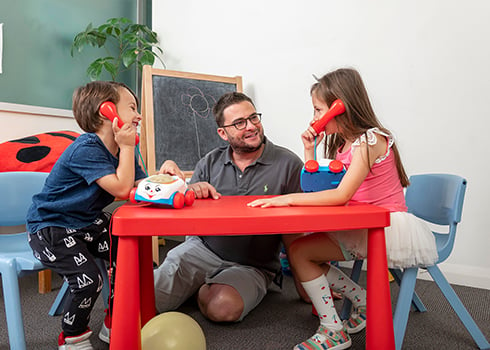What is play?
Play is fun. Play can bring joy, connection, and regulation for all children and adults. Play can look different for everyone and it’s important to remember there is no right or wrong way to play. Play can look like kicking a ball, putting a doll to bed, rolling a car, waving a scarf, lining up objects or repeating certain play sequences.
“Play is a spontaneous, voluntary, pleasurable and flexible activity involving a combination of body, object, symbol use and relationships. In contrast to games, play behaviour is more disorganised, and is typically done for its own sake (i.e., the process is more important than any goals or end points),” - Smith (2013)
“Play is a child’s natural dominant learning approach and contributes to their knowledge and skill development across the cognitive, social/ emotional, creative and physical domains, while also providing a solid foundation for future learning,” - Uren and Stagnitti (2009)
Neurodiversity and play
Thinking about neurodivergent children we often see a diverse range of play skills which we can join in with and support using special areas of interests and passions. Play can be used as opportunities and strengths as a foundation for learning. Here are some autistic strengths to consider in play:
- Specialist knowledge of topics of interest – many children show great imagination and can turn anything into their topic of interest
- Ability to sustain engagement for long periods on topics of interest
- Some children may have an exceptional memory for facts and figures
- Attention to detail – some children may enjoy building things and be able to make complex structures with Lego or magnatiles
- Sensory experiences – many children can enjoy objects in unexpected ways that a neurotypical person wouldn’t have thought of
How to promote authentic play
- Focus on your child’s interests and use what they are motivated by. Your child loves trains, play with trains.
- Join your child where they are at and be prepared to adjust your expectations.
- Follow your child’s play ideas and imitate their actions. Your child likes to move trains and add carriages? Imitate and do the same.
- Don’t direct your child’s play; try and model something new to give ideas instead. Make your train crash into a bridge and say “crash” with no pressure for your child to copy.
- If we start putting demands on play it moves away from true authentic play.
Regulation is important
Regulation can impact on how available your child is to engage with others and be open to new ideas in play. Ask yourself: Has your child got their regulation needs met? What is their capacity? Are they hungry, thirsty, tired, or do they need to use the toilet? Consider the sensory elements too: Is it too noisy? Too bright? Any textures or smells impacting your child? On the flip side, is there anything about the sensory element of the play joyful and motivating for your child? How can you incorporate this next time for more fun?
Consider your communication style
How you communicate will support your child in play. Are you asking too many questions? “What are you doing?” “Where is the doll?” “What’s happening next?” This can be overwhelming for some children.
Consider the purpose of what you are communicating and make sure it is meaningful and productive. Try commenting instead. “That car went so fast!” or “Yum, pizza!” It is important to model something the child can repeat and to adjust your language as needed. For example, is your child using single words? When playing with a ball you could say “roll” or “up” to describe what the ball is doing, but if your child is talking in sentences you could say “The ball is coming fast, like a rocket!”.
Playing with others
It’s important to respect and consider every child’s uniqueness and interests. Some children may not be interested in each other and that’s OK! If your child has expressed an interest in another child, these ideas might be helpful:
- Find a shared interest and start there. Both kids love dinosaurs or sand play? If they both have the same interest it will be easier to connect.
- Do you have double or multiple sets of toys available? This makes it easier to share and take turns.
- Encourage interactions by commenting on what you see e.g. “Look, Johnny is crashing the trains. I am going to try that too.”
- Provide guidance and feedback as needed for success e.g. “let me hold the tower so you can stack the blocks and make it bigger.”
- Model verbal scripts for example “My turn” “Can I have the red train please?”
- Support children to advocate for themselves and how they would like to play.
Remember that play is self-chosen and self-directed and most importantly should be fun for the individual.

